|
| |
British Nuclear Programmes
At the end of the countdown, there was a blinding electric blue light,
of such an intensity I had not seen before or ever since. I pressed my
hands hard to my eyes, then, realised my hands were covering my
eyes. This terrific light power, or rays, were actually passing
through the tarpaulin, through the towel, and through my head and
body, for what seemed ten to twelve seconds, it may have been longer.
After that, the pressure wave, which gave a feeling such as when one
is deep underwater. This was then followed by a sort of vacuum suction
wave, to give a feeling of one's whole body billowing out like a
balloon.
Observer, Mosaic G1 at Monte Bello, 16
May 1956.
We have made a successful start. When the [nuclear] tests are
completed, as they soon will be, we shall be in the same position as
the United States or Soviet Russia. We shall have made and tested the
massive weapons. It will be possible then to discuss on equal terms.
U.K. Prime Minister Harold
Macmillan, 1957
|
Immediately after World War II, in August 1945, the new Labor government in
Britain organized a secret Cabinet committee to establish nuclear policy. On 8
January 1947 this committee of six Ministers (headed by P.M. Attlee) decided to
proceed with development and acquisition of atomic weapons, a fact that was not
disclosed at all until 12 May 1948, when an oblique reference was made to atomic
weapon development in parliamentary discussions. 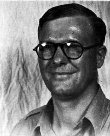
William G. Penney (14 K)
The "Oppenheimer" of Britain was physicist William G. Penney. He was
part of the "British Mission" sent to Los Alamos during the war to
assist in the development of the first atomic bomb. After the war he returned to
the UK and was eventually asked to set up Britain's own nuclear weapon program.
The picture below shows him as he was at Los Alamos. He did not learn of the
british decision to build an atomic bomb unitl May 1947 when he was asked to
lead the development effort. The following month he began assembling a team to
work on it.
The first plutonium production reactor went critical at Windscale (now
Sellafield) in October 1950. The plutonium plant began operation on 25 February
1952, and produced the first plutonium metal 35 days later. Due to the small
size and high population density of Britain no suitable sites for atmospheric
weapons tests existed. Britain thus sought sites in other countries to test its
weapons, finally settling on the Monte Bello Islands in Australia. On 15
September 1952 the plutonium pit for the first British nuclear device, code
named Hurricane, left England.
Hurricane
|
Test:
|
Hurricane
|
|
Time:
|
00:00 03 October 1952 (GMT)
08:00 03 October 1952 (WAST)
|
|
Location:
|
Off Trimouille Island, near Monte Bello Island, 20.40 S, 115.57 E
|
|
Test Height and Type:
|
Ship, -2.7 m
|
|
Yield:
|
25 Kt
|
This was the first British nuclear test. The device tested was a plutonium
implosion bomb similar to the Fat Man, but improved by using a levitated pit.
The bomb used plutonium produced at Windscale (now Sellafield) with a low Pu-240
content since hurried production led to short irradiation times. In fact
Windscale could not quite meet the August 1 deadline for manufacturing the core
and the device also used some Canadian-supplied plutonium.
To test the effects of a ship-smuggled bomb (a threat of great concern to the
British at the time), Hurricane was exploded inside the hull of the HMS Plym
(1450 ton frigate) which was anchored in 40 feet of water 400 yards off shore.
The explosion occured 2.7 m below the water line, and left a saucer-shaped
crater on the seabed 20 feet deep and 1,000 feet across.
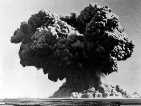 Hurricane (26 K)
Hurricane (26 K)
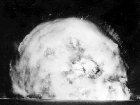 Hurricane - 0.1 seconds (20 K)
Hurricane - 0.1 seconds (20 K)
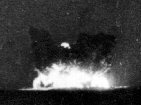 Hurricane - 1 seconds (23 K)
Hurricane - 1 seconds (23 K)
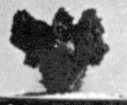 Hurricane - 5 seconds (19 K)
Hurricane - 5 seconds (19 K)
Operation Totem: 1953
This series was intended to develop greater knowledge of fission weapons. The
initial test (Hurricane) had been hurriedly carried out and was poorly
instrumented. Plutonium with a much higher Pu-240 content (and thus lower cost)
was now being produced by Calder Hall and needed to be evaluated in a nuclear
test.
|
Test:
|
Test 1 (T1)
|
|
Time:
|
21:30 14 October 1953 (GMT)
07:00 14 October 1953 (CST)
|
|
Location:
|
Emu Field, South Australia, 28:68 S 132.34 E
|
|
Test Height and Type:
|
Tower, 31 m
|
|
Yield:
|
10 Kt
|
Second British test. The yield was greater than expected.
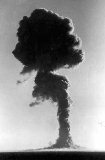 Totem/T1 - First view (10 K)
Totem/T1 - First view (10 K)
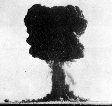 Totem/T1 - Second view (20 K)
Totem/T1 - Second view (20 K)
|
Test:
|
Test 2 (T2)
|
|
Time:
|
21:30 26 October 1953 (GMT)
07:00 26 October 1953 (CST)
|
|
Location:
|
Emu Field, South Australia, 28:70 S 132.35 E
|
|
Test Height and Type:
|
Tower, 31 m
|
|
Yield:
|
8 Kt
|
Third British test. The absolute maximum and minimum yield estimates were 10
and 0.25 Kt respectively, with 2-3 Kt most likely.
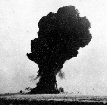 Totem/T2 (21 K)
Totem/T2 (21 K)
Operation Mosaic: 1956
The primary purpose of this test series was to conduct research to support
thermonuclear weapons development.
|
Test:
|
G1
|
|
Time:
|
16 May 1956 (03:50 GMT, 10:50 WAST)
|
|
Location:
|
Off Trimouille Island, near Monte Bello Island, 20.23 S, 115.55 E
|
|
Test Height and Type:
|
Tower, ? m
|
|
Yield:
|
15 kt
|
First British test using fusion fuel (as a physics experiment, not a weapon
test). Fusion yield was negligible.
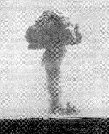 Mosaic/G1 (32 K)
Mosaic/G1 (32 K)
|
Test:
|
G2
|
|
Time:
|
19 June 1956 (02:14 GMT, 10:14 WAST)
|
|
Location:
|
Alpha Island, near Monte Bello Island, 20.40 S 115.53 E
|
|
Test Height and Type:
|
Tower, 31 m
|
|
Yield:
|
98 kt
|
This was the highest yield test ever conducted in Australia. Since the test
yield broke an assurance made personally by PM Anthony Eden of the UK to PM
Robert Menzies of Australia that the yield would not exceed 2.5 time that of
Hurricane (thus about 62 Kt), the true yield was concealed until 1984.
Mosaic G2 was a test of fusion-boosted weapon system, perhaps similar to the
Soviet Sloika ("Layer Cake") or American Alarm Clock designs. It
incorporated lithium-6 deuteride, and had a uranium tamper. The yield was larger
than expected.
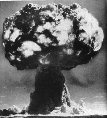 Mosaic G2 - View 1 (33 K)
Mosaic G2 - View 1 (33 K)
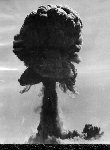 Mosaic G2 - View 2 (16 K)
Mosaic G2 - View 2 (16 K)
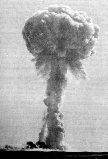 Mosaic G2 - View 3 (15 K)
Mosaic G2 - View 3 (15 K)
Operation Buffalo: 1956
Maralinga Test Range, Australia
This was the first test series at the Maralinga Test Range in South Australia
(bordering Western Australia). It would reused in two other test series.
Buffalo combined atomic (fission) weapons development with weapons effects
testing for military purposes.
|
Test:
|
Round 1, One Tree Site
|
|
Time:
|
27 September 1956 (07:30 GMT, 17:00 CST)
|
|
Location:
|
One Tree Site, Maralinga Test Range
|
|
Test Height and Type:
|
Tower, 31 m
|
|
Yield:
|
15 Kt
|
This was a test of the Red Beard tactical bomb, a plutonium implosion weapon
(expected yield 16 Kt).
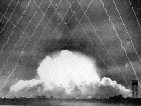 One Tree 1 (29 K)
One Tree 1 (29 K)
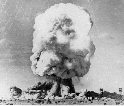 One Tree 2 (26 K)
One Tree 2 (26 K)
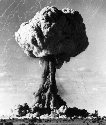 One Tree 3 (21 K)
One Tree 3 (21 K)
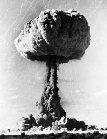 One Tree 4 (18 K)
One Tree 4 (18 K)
|
Test:
|
Round 2, Marcoo Site
|
|
Time:
|
04 October 1956 (07:00 GMT, 16:30 CST)
|
|
Location:
|
Marcoo Site, Maralinga Test Range
|
|
Test Height and Type:
|
Surface, zero meters
|
|
Yield:
|
1.5 Kt
|
This was a test of the Blue Danube bomb equipped with a low yield Mark I
enriched uranium core. The test was exploded on the surface rather than a tower
to collect ground shock and cratering data. The bomb was placed in a shallow pit
so the center of the nuclear reaction would be exactly at the surface. It
produced a 160 ft wide crater, 40 ft deep.
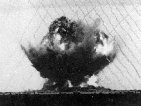 Marcoo 1 (27 K)
Marcoo 1 (27 K)
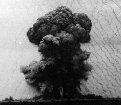 Marcoo 2 (23 K)
Marcoo 2 (23 K)
 Marcoo 3 (15 K)
Marcoo 3 (15 K)
|
Test:
|
Round 3, Kite Site
|
|
Time:
|
11 October 1956 (07:00 GMT, 16:30 CST)
|
|
Location:
|
Kite Site, Maralinga Test Range
|
|
Test Height and Type:
|
Air drop, 150 m
|
|
Yield:
|
3 Kt
|
This was Britain's first air drop test. It tested a Blue Danube bomb dropped
from an RAF Valiant B1 bomber (WZ366 of squadron no. 49). This Service
operational test was originally scheduled for a 40 Kt core, but concerns about
contamination caused a substitution with a low yield bomb core.
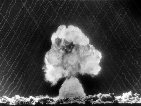 Round 3, Kite (27 K)
Round 3, Kite (27 K)
|
Test:
|
Round 4, Breakaway Site
|
|
Time:
|
22 October 1956 (14:35:00:05 CST)
|
|
Location:
|
Breakaway Site, Maralinga Test Range
|
|
Test Height and Type:
|
Tower, 34 m
|
|
Yield:
|
"Rather less than 16 Kt" (~10 Kt?)
|
This was another test of the Red Beard light weight tactical bomb with some
fusion fuel included as a fusion physics experiment to supplement to Mosaic
data.
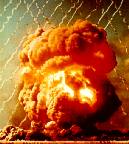 Breakaway (50 K)
Breakaway (50 K)
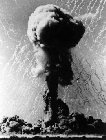 Breakaway - Second View (20 K)
Breakaway - Second View (20 K)
Operation Grapple
The British test program to develop a hydrogen bomb.
|
Test:
|
Grapple 1/Short Granite
|
|
Time:
|
15 May 1957 (19:37 GMT)
|
|
Location:
|
Off Malden Island
|
|
Test Height and Type:
|
Air drop, 2400 m
|
|
Yield:
|
200-300 Kt
|
Dropped by a Valiant B1 bomber (XD818 of Squadron No. 49) piloted by Wing
Commander K. Hubbard. Detonated after 52 sec of free fall.
This was Britain's first test of a radiation implosion thermonuclear bomb
design. The device, named Green Granite Small, weighed 10,000 lb and used a
modified Red Beard primary (called "Tom") and a lead-encased lithium
deuteride secondary (called "Dick"). Most of the yield was from the
secondary, providing evidence of successful radiation implosion, but the yield
was far below the predicted value (about 1 megaton was expected).
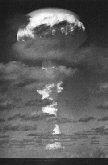 Grapple 1/Short Granite (60 K)
Grapple 1/Short Granite (60 K)
|
Test:
|
Grapple X/Round C
|
|
Time:
|
8 November 1957 (17:47 GMT)
|
|
Location:
|
Off Christmas Island
|
|
Test Height and Type:
|
Air drop, 2250 m
|
|
Yield:
|
1.8 Megatons
|
Dropped by a Valiant bomber (XD824) piloted by Squadron Leader Barney Millett.
Detonated after 52 sec of free fall.
This was Britain's first truly successful thermonuclear bomb test. The test
seems to have been hastily arranged. The bomber squadron was only notified about
the test in September, followed by four weeks of intensive training in
preparation. Documents indicate this test had not even been contemplated prior
to the spring Grapple shots. The probable reason for this was that it was a
rushed redesign following the disappointing Short Granite and Purple Granite
shots, spurred on by British fears of an imminent test ban. Only one device,
designated Round C, was tested with a yield of 1.8 Mt. This was Britian's first
megaton-class explosion, showing that the UK had achieved mastery of H-bomb
design.
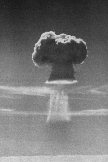 Grapple X/Round C (60 K)
Grapple X/Round C (60 K)
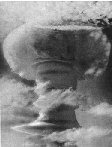 Grapple X/Round C (84 K)
Grapple X/Round C (84 K)
|
Test:
|
Grapple Y
|
|
Time:
|
8 April 1958 (19:05 GMT)
|
|
Location:
|
Off Christmas Island
|
|
Test Height and Type:
|
Air drop, 2350 m
|
|
Yield:
|
2 Megatons
|
Dropped by a Valiant bomber (XD825) piloted by Squadron Leader Bob Bates.
Detonated 53 seconds after release, only 245 yards off target. This was
Britain's fourth test of a radiation implosion thermonuclear bomb, and the
second successful high yield test.
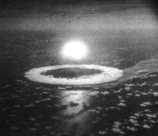 Grapple Y
at Detonation Grapple Y
at Detonation
|
Test:
|
Grapple Z/Flagpole 1
|
|
Time:
|
2 September 1958 (17:24 GMT)
|
|
Location:
|
Off Christmas Island
|
|
Test Height and Type:
|
Air drop, 2850 m
|
|
Yield:
|
2.5-3 Megatons
|
Dropped by a Valiant bomber (XD822) piloted by Bill Bailey from 45,000 ft,
missed target point by a mere 95 yards. The first British use of blind radar
bombing with a nuclear device. This was Britain's fifth test of a radiation
implosion thermonuclear bomb. It was the first of Britain's two highest yield
tests.
 Grapple Z/Flagpole 1 (68 K)
Grapple Z/Flagpole 1 (68 K)
|
Test:
|
Grapple Z/Halliard 1
|
|
Time:
|
11 September 1958 (17:49 GMT)
|
|
Location:
|
Off Christmas Island
|
|
Test Height and Type:
|
Air drop, 2650 m
|
|
Yield:
|
2.5-3 Megatons
|
Dropped by a Valiant bomber (XD827) piloted by Flight Lieutenant Tiff
O'Connor. This was the second of Britain's two highest yield tests.
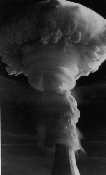 Grapple Z/Halliard 1 (68 K)
Grapple Z/Halliard 1 (68 K)
Christmas Island
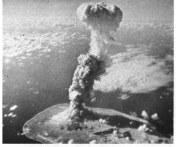
Test over Christmas Island.
Joint US - UK Testing
After the 1957-1958 test series the United Kingdom ceased conducting its own
independent nuclear tests. The reason for this was that it was no longer
necessary. After the UK had demonstrated that it could develop thermonuclear
weapons, the US adopted it as a strategic partner in deterring the Soviet Union.
All subsequent UK nuclear weapons are based on US designs, which were made
available to Britain. Once nuclear testing resumed in 1961, the US and UK also
began conducting joint tests at hte NTS (Nevada test Site) in Nevada, eventually
conducting a total of 28 (counting four zero-yield plutonium dispersal safety
experiments). The first was the Pampas shot during Operation Nougat, 1 March
1962 (yield 9.5 Kt). See summary table below for complete listing of these
tests.
After the Grapple tests, the British lent Christmas island to the US in 1962
for the Dominic series of 25 tests.
British Testing Summary
UK Atmospheric Nuclear Tests in Australia and at Christmas
Island 1952-58
|
Test Series
|
Test Name
|
Location
|
Date
|
Yield
|
Explosion Conditions
|
Comments
|
|
|
Hurricane
|
Monte Bello (off Trimouille Is)
|
3 Oct 1952
|
25 Kt
|
Ocean surface burst (HMS Plym)
|
Levitated core plutonium implosion device
|
|
Totem
|
Test 1
|
Emu Field
|
15 Oct 1953
|
10 Kt
|
Tower
|
|
|
Totem
|
Test 2
|
Emu Field
|
27 Oct 1953
|
8 Kt
|
Tower
|
|
|
Mosaic
|
G1
|
Monte Bello (off Trimouille Is)
|
16 May 1956
|
15 Kt
|
Tower
|
|
|
Mosaic
|
G2
|
Monte Bello (off Alpha Is)
|
19 June 1956
|
60 Kt
|
Tower
|
|
|
Buffalo
|
One Tree, Round 1
|
Maralinga (One Tree)
|
27 Sept 1956
|
15 Kt
|
Tower
|
|
|
Buffalo
|
Marcoo, Round 2
|
Maralinga (Marcoo)
|
4 Oct 1956
|
1.5 Kt
|
Ground
|
|
|
Buffalo
|
Kite, Round 3
|
Maralinga (Kite)
|
11 Oct 1956
|
3 Kt
|
Airburst over land
|
|
|
Buffalo
|
Breakaway, Round 4
|
Maralinga (Breakaway)
|
22 Oct 1956
|
10 Kt
|
Tower
|
|
|
Grapple
|
Grapple 1/Short Granite
|
Malden Is, Pacific
|
15 May 1957
|
200-300 Kt
|
Airburst over ocean
|
Radiation implosion thermonuclear device; 1 Mt predicted, some
thermonuclear yield achieved
|
|
Grapple
|
Grapple 2/Orange Herald
|
Malden Is, Pacific
|
31 May 1957
|
720 Kt
|
Airburst over ocean
|
Fall back thermonuclear device, Alarm Clock/Sloika design using U-235
core
|
|
Grapple
|
Grapple 3/Purple Granite
|
Malden Is, Pacific
|
19 Jun 1957
|
150 Kt
|
Airburst over ocean
|
Second radiation implosion thermonuclear device, 1 Mt predicted
|
|
Antler
|
Round 1
|
Maralinga (Tadje)
|
14 Sept 1957
|
1 Kt
|
Tower
|
|
|
Antler
|
Round 2
|
Maralinga (Biak)
|
25 Sept 1957
|
6 Kt
|
Tower
|
Lightweight plutonium implosion device named Indigo Hammer, intended
for air defense missile (Bloodhound) and thermonuclear primary
applications
|
|
Antler
|
Round 3
|
Maralinga (Taranaki)
|
9 Oct 1957
|
25 Kt
|
Balloon-burst over land
|
|
|
Grapple X
|
Round C
|
Christmas Is
|
8 Nov 1957
|
1.8 Mt
|
Airburst over ocean
|
|
|
Grapple Y
|
Grapple Y
|
Christmas Is
|
28 Apr 1958
|
2 Mt
|
Airburst over ocean
|
|
|
Grapple Z
|
Pennant 2
|
Christmas Is
|
22 Aug 1958
|
~1 Mt
|
Balloon-burst over land
|
|
|
Grapple Z
|
Flag Pole 1
|
Christmas Is
|
2 Sept 1958
|
2.5-3 Mt
|
Airburst over ocean
|
|
|
Grapple Z
|
Halliard 1
|
Christmas Is
|
11 Sept 1958
|
2.5-3 Mt
|
Airburst over ocean
|
|
|
Grapple Z
|
Burgee 2
|
Christmas Is
|
23 Sept 1958
|
1 Kt
|
Balloon-burst over land
|
|
Joint US-UK Tests
Legend:NAFR= Nellis Air Force Range (Nevada); NTS= Nevada Test Site
|
Test Series
|
Test Name
|
Date (GCT)
|
Location
|
Test Type
|
Yield (Kt)
|
Purpose
|
Comments
|
|
Nougat
|
Pampas
|
1-Mar-62
|
NTS
|
Shaft
|
9.5 Kt
|
Accidental release of radioactivity detected off-site
|
|
Roller Coaster
|
Double Tracks
|
15-May-62
|
NAFR
|
Surface
|
0
|
Storage-transportation safety experiment, measured plutonium dispersal
risk
|
|
Roller Coaster
|
Clean Slate I
|
25-May-62
|
NAFR
|
Surface
|
0
|
Storage-transportation safety experiment, measured plutonium dispersal
risk
|
|
Roller Coaster
|
Clean Slate II
|
31-May-62
|
NAFR
|
Surface
|
0
|
Storage-transportation safety experiment, measured plutonium dispersal
risk
|
|
Roller Coaster
|
Clean Slate III
|
9-Jun-62
|
NAFR
|
Surface
|
0
|
Storage-transportation safety experiment, measured plutonium dispersal
risk
|
|
Storax
|
Tendrac
|
7-Dec-62
|
NTS
|
Shaft
|
<20 Kt
|
|
|
Whetstone
|
Cormorant
|
17-Jul-64
|
NTS
|
Shaft
|
<20 Kt
|
Accidental release of radioactivity detected on-site only
|
|
Whetstone
|
Courser
|
25-Sep-64
|
NTS
|
Shaft
|
0
|
|
|
Flintlock
|
Charcoal
|
10-Sep-65
|
NTS
|
Shaft
|
20 - 200 Kt
|
|
|
Arbor
|
Fallon
|
23-May-74
|
NTS
|
Shaft
|
20 - 200 Kt
|
|
|
Anvil
|
Banon
|
26-Aug-76
|
NTS
|
Shaft
|
20 - 150 Kt
|
|
|
Cresset
|
Fondutta
|
11-Apr-78
|
NTS
|
Shaft
|
20 - 150 Kt
|
|
|
Quicksilver
|
Quargel
|
18-Nov-78
|
NTS
|
Shaft
|
20 - 150 Kt
|
|
|
Quicksilver
|
Nessel
|
29-Aug-79
|
NTS
|
Shaft
|
20 - 150 Kt
|
|
|
Tinderbox
|
Colwick
|
26-Apr-80
|
NTS
|
Shaft
|
20 - 150 Kt
|
|
|
Guardian
|
Dutchess
|
24-Oct-80
|
NTS
|
Shaft
|
<20 Kt
|
|
|
Guardian
|
Serpa
|
17-Dec-80
|
NTS
|
Shaft
|
20 - 150 Kt
|
|
|
Praetorian
|
Rousanne
|
12-Nov-81
|
NTS
|
Shaft
|
20 - 150 Kt
|
|
|
Praetorian
|
Gibne
|
25-Apr-82
|
NTS
|
Shaft
|
20 - 150 Kt
|
|
|
Phalanx
|
Armada
|
22-Apr-83
|
NTS
|
Shaft
|
<20 Kt
|
|
|
Fusileer
|
Mundo
|
1-May-84
|
NTS
|
Shaft
|
20 - 150 Kt
|
|
|
Grenadier
|
Egmont
|
9-Dec-84
|
NTS
|
Shaft
|
20 - 150 Kt
|
|
|
Charioteer
|
Kinibito
|
5-Dec-85
|
NTS
|
Shaft
|
20 - 150 Kt
|
|
|
Charioteer
|
Darwin
|
25-Jun-86
|
NTS
|
Shaft
|
20 - 150 Kt
|
|
|
Musketeer
|
Midland
|
16-Jul-87
|
NTS
|
Shaft
|
20 - 150 Kt
|
|
|
Aqueduct
|
Barnwell
|
18-Dec-89
|
NTS
|
Shaft
|
20 - 150 Kt
|
|
|
Sculpin
|
Houston
|
14-Nov-90
|
NTS
|
Shaft
|
20 - 150 Kt
|
|
|
Julin
|
Bristol
|
26-Nov-91
|
NTS
|
Shaft
|
<20 Kt
|
|
|